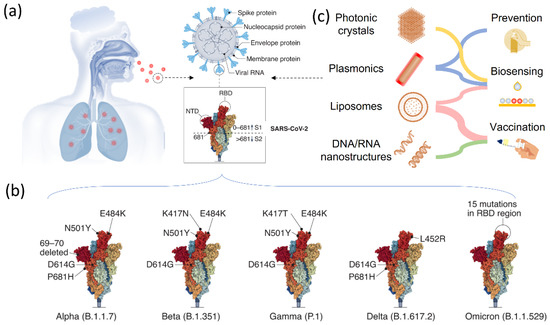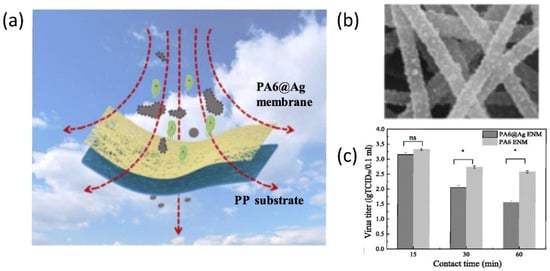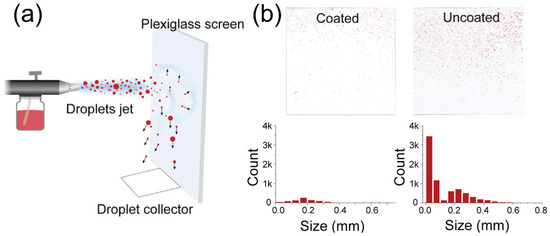Your browser does not fully support modern features. Please upgrade for a smoother experience.
Please note this is a comparison between Version 1 by Zhiwei Li and Version 2 by Rita Xu.
The coronavirus disease 2019 (COVID-19) pandemic, caused by the severe acute respiratory syndrome coronavirus 2 (SARS-CoV-2), has raised great concerns about human health globally. Prevention and vaccination are still the most efficient ways to slow down the pandemic and to treat SARS-CoV-2 in various aspects.
The coronavirus disease 2019 (COVID-19) pandemic, caused by the severe acute respiratory syndrome coronavirus 2 (SARS-CoV-2), has raised great concerns about human health globally. At the current stage, prevention and vaccination are still the most efficient ways to slow down the pandemic and to treat SARS-CoV-2 in various aspects.
- SARS-CoV-2
- COVID-19 pandemic
- smart nanostructures
- biosensing
- detection
- vaccination
1. Introduction
The spread of SARS-CoV-2 has caused the coronavirus 2019 (COVID-19) disease and the pandemic worldwide [1][2][3][1,2,3]. According to the weekly report of the World Health Organization (WHO) as of 25 September 2022, 612 million confirmed cases have been reported, leading to 6.5 million deaths by COVID-19 globally. Although the number of newly reported cases decreases by 11% and new weekly reported deaths decrease by 18% compared with the previous week, there is no convincing evidence and global confidence indicating the end of the COVID-19 pandemic so far [4][5][6][4,5,6]. Additionally, the up-to-date death rate caused by the SARS-CoV-2 is 1.06%, which is higher than the 0.6% in the 1957 influenza pandemic, although the latest rates decreased from case fatality rates of 3.3% about two years ago (as of 9 September 2020). In addition to the coronavirus SARS-CoV-2 itself, there has been a trend of outbreaks of various variants globally, making the current situation unpredictable regarding the spreading of the pandemic [7][8][9][10][11][7,8,9,10,11]. It is therefore becoming increasingly important to develop biosensing strategies as well as reliable coronaviral vaccines to prevent and treat the SARS-CoV-2 and its variants of concerns [12].
In many established strategies for coronavirus regulation, nanostructured materials that can actively respond to external stimuli are playing increasingly important roles [13][14][15][13,14,15]. Their unique capabilities to sense and specifically respond to external physical and chemical stimuli represent widely accessible platforms to develop active smart coatings for virus prevention, to be incorporated to advanced sensing devices for coronavirus detection, and to be used for responsive delivery systems for SARS-CoV-2 vaccination [16][17][18][16,17,18]. They have demonstrated their great global success in many aspects in fighting against the COVID-19 pandemic. For example, some emerging techniques have been proposed to functionalize conventional masks with active nanostructures [19]. These innovations are expected to improve prevention efficacy of masks in social activities. Another promising example is the use of photonic crystals and plasmonic nanostructures in developing high-performance virus biosensors [20][21][22][20,21,22]. These responsive nanostructured materials can provide both colorimetric changes for fast, point-of-care detection and spectroscopic readouts for precise quantitative evaluation. In developing coronavirus vaccinations, nanostructured materials have been used to deliver biological species for triggering in vivo immune responses. The introduction of lipid nanostructures as a biocompatible carrier to deliver RNA has been used in commercial vaccines, which have demonstrated the highest efficacy based on clinical data [23][24][25][23,24,25]. Considering these exciting developments, it is critical to summarize the design principles and working mechanisms of this unique set of nanostructured materials in coronavirus regulation. Although there are some reviews providing an overview of materials science in fighting against COVID-19 or summarizing research activities in specific aspects (sensing or vaccination) [26][27][28][29][26,27,28,29], a focused review on recent advances in creating smart nanostructured materials for the SARS-CoV-2 treatment is necessary to understand the general concepts underlying these remarkable materials and to overcomes existing challenges in tackling COVID-19.
2. SARS-CoV-2 and VOCs
The structure of the RNA virus SARS-CoV-2 is depicted in Figure 1a, with its viral RNA encapsulated in the membrane protein [30][31][32][30,31,32]. It comprises five basic functional structures: a spike protein, envelop protein, membrane protein, nucleocapsid protein, and the viral RNA ranking from the exterior to the interior. More specifically, the SARS-CoV-2 is a positive-strand RNA virus (+ssRNA virus), which contains ~29-kilobase single-stranded, positive-sense genomes made of ribonucleic acid. The spike protein known as S protein on the surface regulates the receptor recognition and cell membrane fusion and therefore is one of the most important functional proteins of the virus [7][33][34][7,33,34]. It has two subunits, S1 and S2 on the virus membrane, with a total number of amino acids larger than 1200. The S1 subunit contains a domain that can recognize and bind to the receptor angiotensin-converting enzyme 2. The S2 subunit is responsible for cell membrane fusion through the formation of a six-helical bundle based on a two-heptad repeat domain [35]. Therefore, the S protein has been extensively studied so far for developing vaccines for tackling the coronavirus pandemic, for investigating immune responses, and for tracking genetic mutations among various variants [36][37][38][36,37,38]. Among these complex structures and diverse amino acid constituents, only a small amino acid stretch is directly related to the interactions between the receptor-binding domain and the enzyme 2 receptor of the host cells. Figure 1b shows the key mutations on the S protein that are noted in all VOC so far, indicating the important role of the S protein in virus mutation and vaccination.
Figure 1. Smart nanostructured materials for SARS-CoV-2 and variants biosensing, treatment, and vaccination. (a) Scheme of smart nanostructured materials for COVID-19 treatment. (b) The structure of SARS-CoV-2 and the major components, including the S protein, nucleocapsid protein, envelope protein, membrane protein and viral RNA. (c) SARS-CoV-2 variants of concerns. Reprinted from [30], with permission from Springer Nature (Berlin/Heidelberg, Germany).
3. Nanostructured Materials for COVID-19 Prevention
One effective way to slow down virus spread is to physically isolate the infectious viruses that are suspended in air. A few common practices nowadays include keeping social distance and wearing personal protective equipment (masks, gloves, face shields, and protective suits). In addition to these common practices, researchers are seeking ways to prevent the spread of the coronavirus using nanostructured filters or coatings, which aim to reduce the number of virus particles suspended in air by capturing them on demand. In the classic design of air filters, filters with regular pores allow selective transport to particulate matters of different sizes. Only particulate matters or nanoscale particles with sizes smaller than the pore diameters can pass through the filters, leaving larger ones blocked and separated. This working mechanism is operational for particulate matters as well as biological species. Functionalizing the filtering materials represents an advanced technique to improve the efficiency [56][57][58][56,57,58]. For example, the top-down fiber manufacturing is a typical method to prepare functional filters, which can be explained by a Brownian diffusion mechanism [59][60][61][59,60,61]. An Al-coated conductive fibrous filter demonstrated an efficiency of >99.99% nanoparticle capture by using electrostatic interactions [62]. However, these strategies require the additional integration of a nanogenerator set and some filters also need ultra-high voltage, which limits their practical use. To overcome these existing challenges, a self-powered filter based on ionic liquid polymer composites was developed with improved hydrophilicity and conductivity, high absolute electrostatic potential, and power generation ability to remove nanoparticles and particulate matters [63]. This self-powered filter was prepared by polymerizing a hydrophilic copolymer on a melamine-formaldehyde (MF) resin sponge. Such highly porous structures allow polluted air to flow through the filter without too much pressure drop while enhancing the particle and virus-removal efficiency, owning to their high surface areas and porosity. This filter demonstrates a high efficiency in removing particulate matters by generating a strong electric field under a low voltage of 3 V. Such a low voltage could be supplied by a silicon solar panel, granting this filter great potential in creating self-powered wearable cleaning devices. Functionalizing nanofibers with active nanostructures will provide additional antibacterial and antiviral properties in addition to passive filtration [64][65][66][67][64,65,66,67]. To this end, Ag nanoparticles have been long recognized for their excellent antibacterial performances [68][69][70][71][68,69,70,71]. A typical scheme for classic air filter with antibacterial and antiviral properties is shown in Figure 2a [72]. In this work, a polar polymer, PA6, was made into nanofibers by electrospinning and deposited on a polypropylene substrate. Ag nanoparticles were decorated on the fibrous membranes through a impregnation method (SEM in Figure 2b). Such nanostructured films were used as active filters, which removed suspended bacteria and virus based on the antibacterial and antiviral properties of the guest Ag nanoparticles (Figure 2c).
Figure 2. Responsive nanostructured materials for potential COVID-19 treatment and prevention. (a) Schematic illustration of nanostructured filter. (b) The SEM image of the nanostructured fibers decorated with Ag nanoparticles. (c) The viral titer measurement at different contact time. ns: not significant difference; * p < 0.05. Reprinted from [72], with permission from Elsevier Inc (Amsterdam, The Netherlands).

Figure 3. Nanostructured coating for COVID-19 treatment and prevention. (a) Schematic illustration of spray experiment for accessing the treatment performance. (b) Photos and corresponding histograms showing the droplet marks and their size distributions, respectively. Reprinted from [75], with permission from Elsevier Inc.
